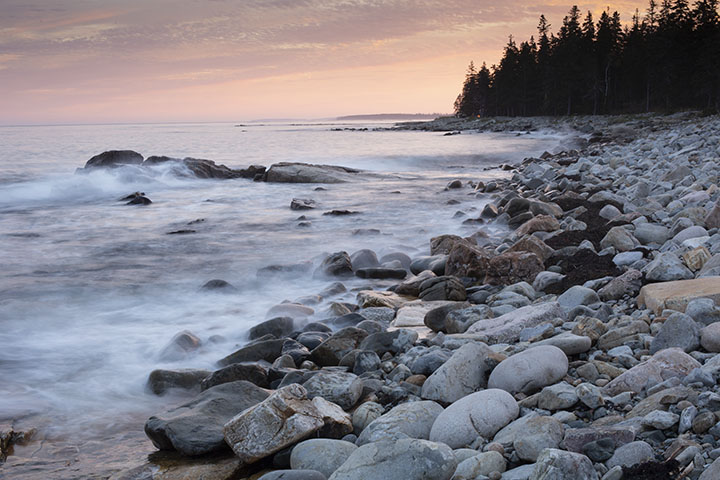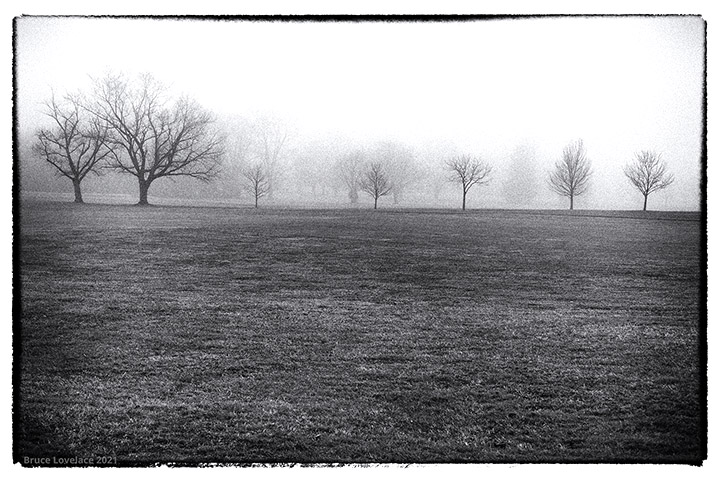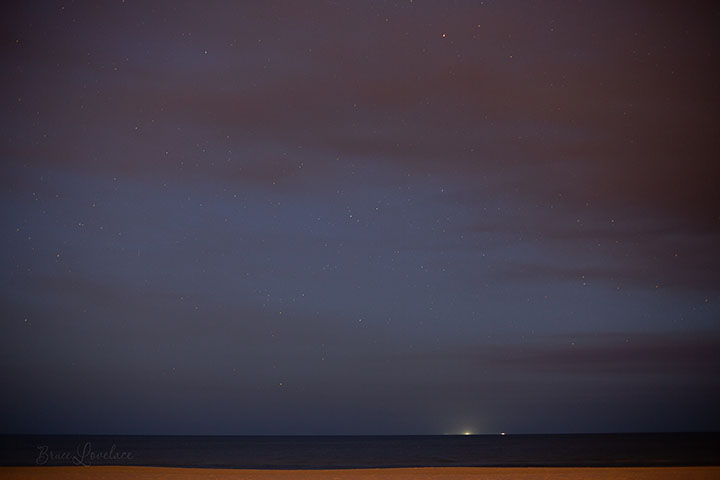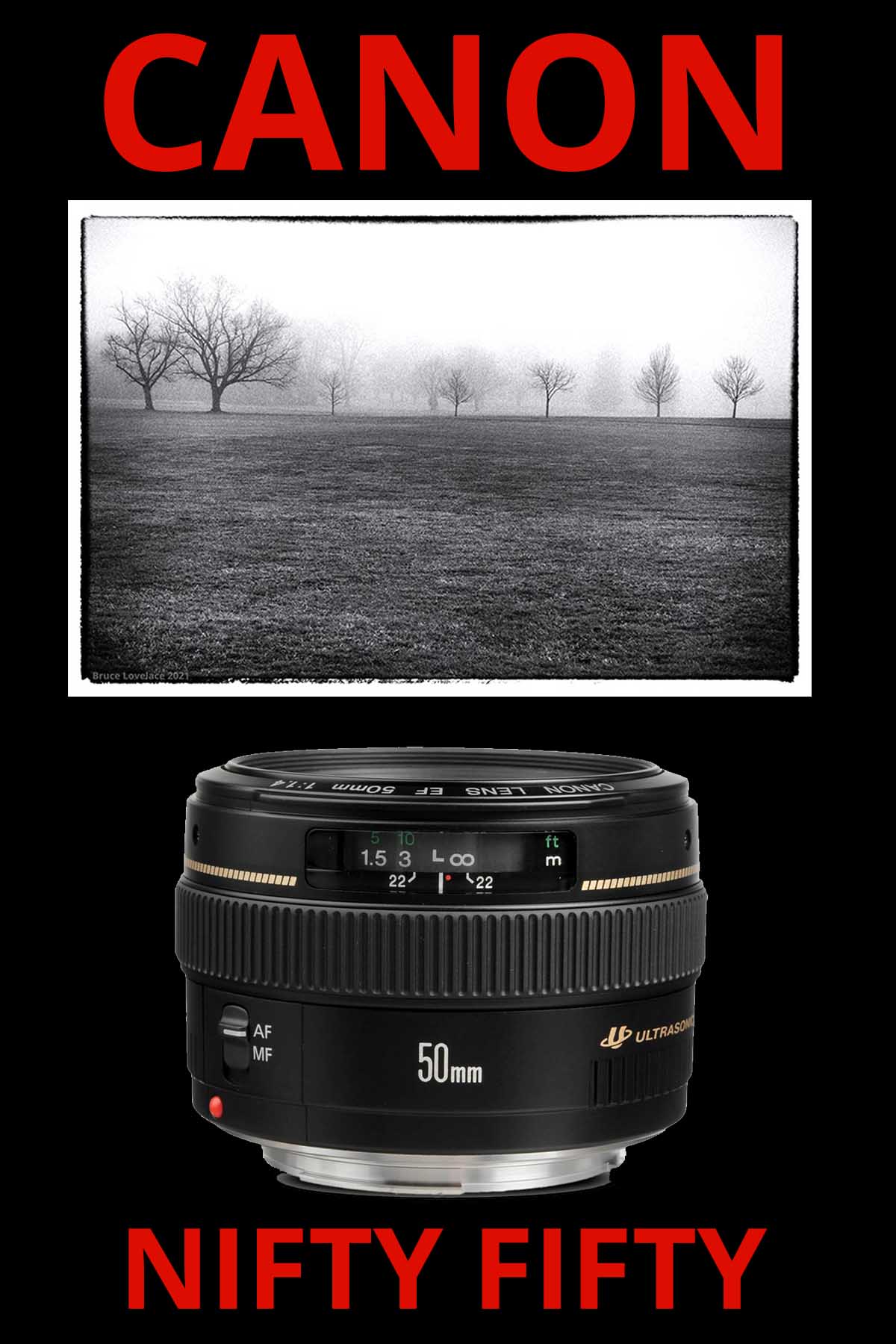Is The Canon 50mm f/1.4 Lens any good
WRITTEN BY: BRUCE LOVELACE
UPDATED: March 26, 2024
I was wondering whether the Canon 50mm f/1.4 was any good. You're likely curious too if this 50mm "prime" lens is worth it. This nifty fifty lens falls in between the 50mm f/1.8 and the 50mm f/1.2 in terms of price and quality. Like the story of Goldilocks and the 3 bears, you simply find the right version of the 50mm lens for your situation.
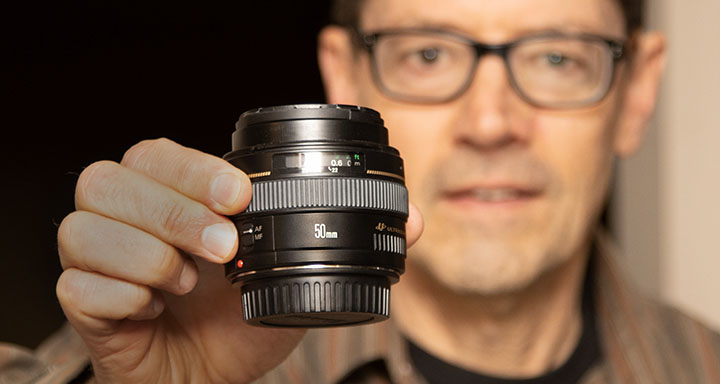 Time to test the Canon EF 50mm f/1.4 Lens
Time to test the Canon EF 50mm f/1.4 LensIn addition to wanting to know if this f/1.4, 50mm lens by Canon is a good lens, you're likely also interested in what a 50mm lens is used for. We'll get to that in a second. First, we'll look at the value of this lens.
The Canon EF 50mm f/1.4 lens is an outstanding value. It's much cheaper priced than the Canon EF 50mm f/1.2 and much better quality that the Canon EF 50mm f/1.8. The 50mm focal length makes it suitable for photographing a large variety of subjects. The large maximum aperture of f/1.4 makes it a great lens for shooting in low-light situations.
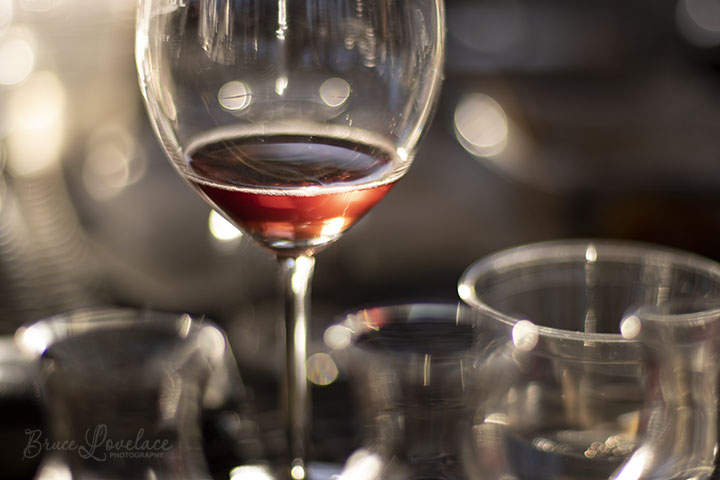 The first test photo I took with my new 50mm f/1.4 Lens
The first test photo I took with my new 50mm f/1.4 LensI was very pleased with the bokeh from a 50mm lens
The question that comes up next is whether the 50mm focal length is versatile enough. Surprisingly, you can use a 50mm lens for a variety of different types of photography. Here's some thoughts on how you can use the EF 50mm f/1.4 lens.
what's the Canon 50mm f/1.4 good for
What is a 50mm f/1.4 lens good for?
Many of us Canon shooters have been spoiled by the large number of quality zoom lenses in the Canon collection and have ignored the non-zooming prime lenses. Prime lenses have several strong features that make them a solid choice as a lens to use.
Here's another Canon 50mm f/1.4 sample image. I took this photo just after sunset on an unseasonably warm evening in October in Acadia National Park.
50mm lenses are good for the following 5 kinds of photography.
1. low-light photography
The 50mm f/1.4 lens is good for existing light photography where you can't or don't want to use your flash. Wedding photographers love to use f/1.4 when they can't use a flash.
Whether its dark because it's dawn or dusk, a cloudy day, or you're shooting indoors, the Canon 50mm f/1.4 lets in four times as much light as one of the "fast" Canon f/2.8 zoom lenses.
You're less likely to get motion blur in your photos because you'll have the ability to use a faster shutter speed when your lens aperture goes that wide.
The indoor photo above was made possible without flash by using the "fast" 50mm lens with its maximum aperture of f/1.4 set on the lens and a high ISO setting on the camera.
2. portraits
The Canon 50mm f/1.4 lens is good for shooting portraits. Yes, in fact shooting portraits is likely the most popular way this lens is used. This is for two good reason. A 50mm focal length gives you a good working distance that creates a similar "normal" perspective that you get with the human eye.
Secondly, with such a large aperture, you can get beautifully blurred out backgrounds. See the portrait example below.
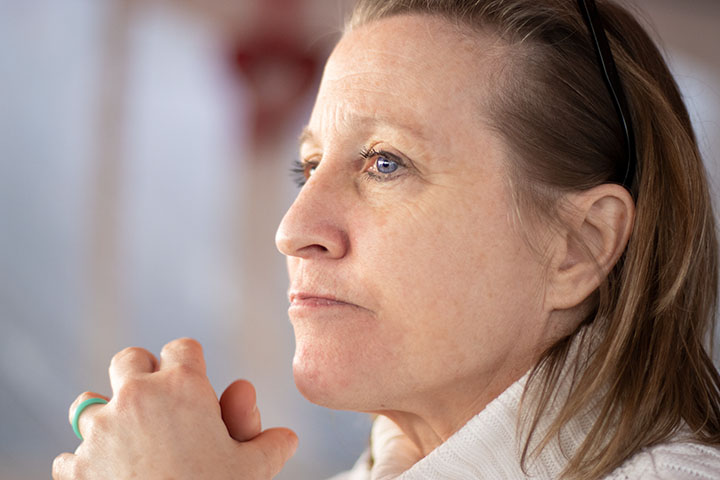 "Candid Portrait"
"Candid Portrait"Canon 90D, Canon 50mm f/1.4, 1/200 second @ f/1.4, ISO 800
This portrait was shot in a dimly lit outdoor tent, close to sunset, with the f/1.4 lens wide open. I placed the point of focus on my subject's eye which helped render the background pleasantly out of focus.
3. macro photography
Add in an extension tube or two and the 50mm lens can be used to shoot macro. By itself, the 50mm f/1.4 has a pedestrian .15x maximum magnification with a minimum focus distance of about 18 inches. But, don't despair.
You do have options. One of my favorite tricks is to use one or more extension tubes with my prime lens to decrease the minimum focusing distance and get great quality close-up photos.
I do this with both the f/1.4 nifty fifty lens as well as with my Canon 85mm f/1.8 prime. Check out the comparison photos below. The toy train is approximately 4.5 inches long.
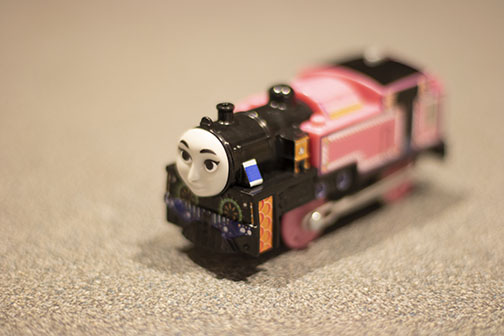 50mm lens without extension tube
50mm lens without extension tube(Focusing distance about 18 inches)
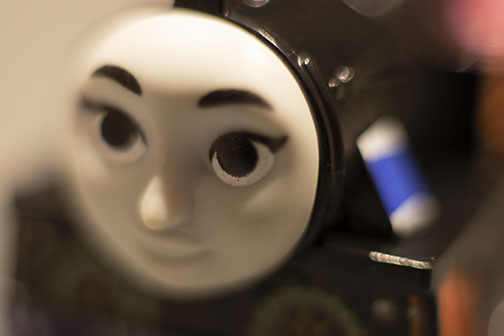 50mm lens with 25mm extension tube
50mm lens with 25mm extension tube(Focusing distance about 3 inches)
With a 25mm extension tube attached between my 90D and the lens, the 50mm f/1.4 becomes a macro lens. Being a prime lens, it's lightweight, sharp at all apertures, and chromatic aberations are at a minimum.
4. landscape photography
The 50mm f/1.4 lens can be used to photograph landscapes. One of the most common tendencies both newbie photographers and advanced shooters have is to limit composing their landscape photos with wide angle lenses. Although wide angle lenses are the best choice in many instances, the 50mm focal length shouldn't be ignored.
Using the 50mm f/1.4 lens for landscape photos will give you more detail type of shots. Some of my favorite landscapes are closer, less cluttered images that bring out the patterns and textures in nature that we can easily overlook.
5. astrophotography
The Canon 50mm f/1.4 is perfect for experimenting with astrophotography. Most astrophotography is shot with wide angle lenses, but the fast wide angle lenses are super pricey. The 50mm focal lenght will give you closer views to your subject than the wide angle lenses.
For the sharpest results, you'll actually want to stop down the lens to f/2.0. The widest aperture lenses, like the Canon f/1.4 are more suitable to capture the nighttime sky because they allow so much more light into your camera.
If you're using a lens that doesn't have a wide aperture like f/1.4 you're forced into using extremely high ISO settings to get a good exposure. High ISO setting photos have more noise and poor detail compared to photos where a low ISO was used.
Similar to the situation with shooting landscapes, wide angle lenses are often thought of as the only kind of lens to use. You can get tighter views of the night time stars with the 50mm f/1.4.
Canon EF 50mm f/1.4 lens compatibility
One common question that's frequently asked is if the 50mm lens is for full frame cameras.
The Canon 50m lens is designed for full frame cameras, but is compatible with full frame and crop sensor Canon bodies. When attached to an APS-C crop camera, like the 70D 80D, 90D, t7i, t8i, 7D Mark II, SL2, or SL3, the field of view is equivalent to that of an 80mm lens. That means it is classified as a moderate prime telephoto lens on the smaller APS-C cameras.
is the canon f/1.4 the best 50mm lens
You can find the complete comparison of the four options for Canon 50mm lenses here, but I will say this. The f/1.4 is the best fit for me. It's an affordable compromise over the pricey f/1.2 and delivers superior performance and better durability than the plastic nifty fifty f/1.8 version of this lens. The macro version of the Canon 50mm lens wasn't fast enough for me to consider.
For me, the biggest appeal of the Canon EF 50mm f/1.4 lens is using it at its wide open aperture and intentionally using that extremely shallow depth of field as a creative tool.
I hope you found this post helpful. For related articles, use the links below my signature. For more Canon equipment topics, visit my Search For An Article page.
Stay inspired. Shoot a Canon!
As an Amazon affiliate Canon Camera Geek receives a small commission from qualifying purchases, at NO added cost to you.

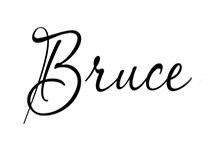
Bruce Lovelace is the publisher of Canon Camera Geek. Read more about him on the About Page. He also publishes how to articles and camera gear reviews at the Photography Tips website.
View some of Bruce's photos on Instagram and Flickr. Join the tribe of followers on YouTube. Bruce also runs photo workshops and provides 1 on 1 digital photography coaching.
Recent Articles
-
Choose the Right Memory Card for Your Canon R6 Mark II: Speed And Size
Nov 05, 25 02:04 PM
R6 Mark II Memory Card -
Canon G1x Mark II vs G1X-Side By Side Comparison of Canon G1X Cameras
Oct 22, 25 08:35 AM
G1 X Mark II vs. G1 X: Is the New Version a HUGE Leap... Or a Massive Mistake? Canon responded to the criticisms of the original G1X. Canon G1X Mark II vs G1X -
Sony RX100 III vs G1x Mark II by Canon. Side by Side Comparison
Oct 22, 25 08:07 AM
It's another one of those epic camera battles, this time not the Canon vs Nikon but rather the RX100 III Vs G1X Mark II battle. -
Canon R6 Mark II FAQ. Answers To All of Your Canon R6 M2 Questions
Sep 01, 25 07:51 AM
There's a lot you can easily learn about Canon's mirrorless R6 Mark II camera. Get your questions answered in this R6 Mark II FAQ -
Canon G1X Sensor Size. What Are The Specs on The Canon G1X Sensor
Aug 26, 25 11:39 AM
Here is a comparison of the Canon G1X sensor size with the rest of the "G" series Canon cameras -
Macro Photography With the Canon G1X Mark II- G1X Close-up Flowers
Aug 26, 25 11:24 AM
Use these helpful tips for your macro photography with the Canon G1X Mark II and its re-designed lens. Here are the sample close up photos of flowers
